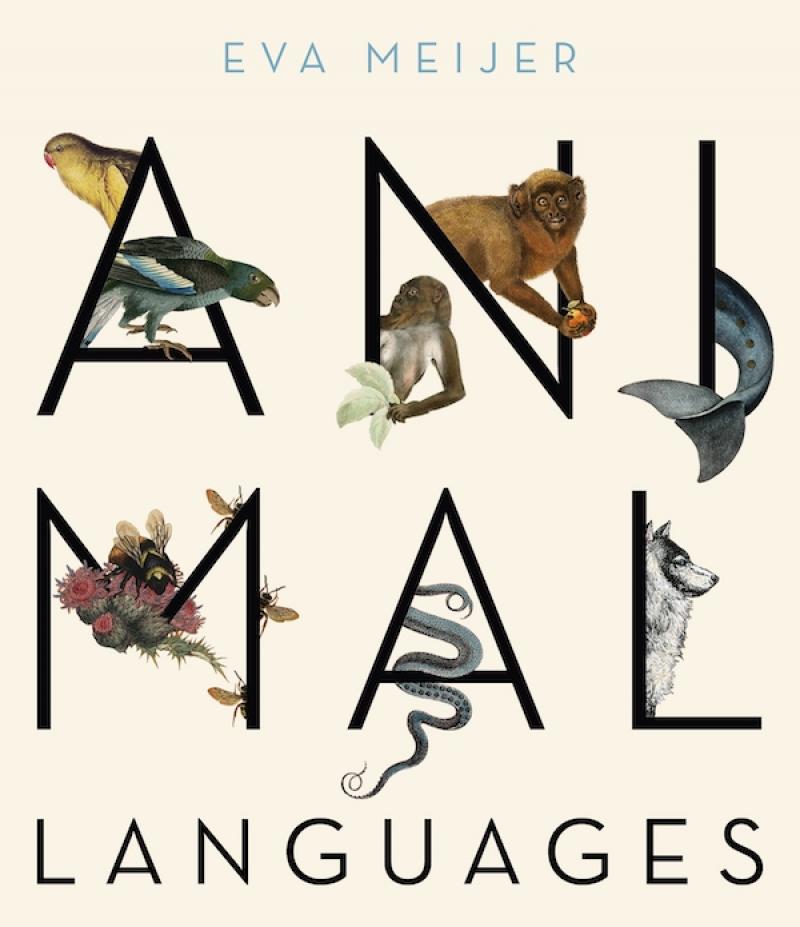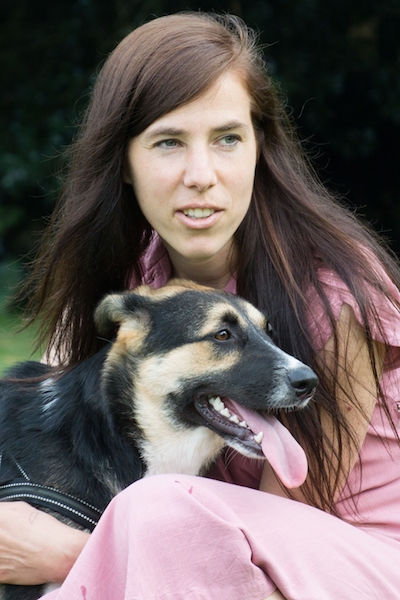Eva Meijer: Animal Languages review - do you talk crow? | reviews, news & interviews
Eva Meijer: Animal Languages review - do you talk crow?
Eva Meijer: Animal Languages review - do you talk crow?
Engrossing and accessible overview of the animal world's secret conversations

Animal intelligence has come to the fore as an essential and fashionable subject for study. Dolphins, elephants, bees, prairie dogs, gannets, whales, baboons, wolves, parrots, bats – not mention lance-tailed manakins and grey mouse lemurs – are just a few of our fellow creatures whose social behaviour is the subject of this pithy, elegant book.
Although her book is dedicated to a number of animal companions, Eva Meijer does not approve of pets. Yet as any pet owner or farmer knows, groups of dogs, cats, cows, pigs and chickens can communicate. We acknowledge animal emotion, and recognise what appears to be grief, affection, altruism and empathy. But behind the wealth of incidents and episodes Meijer relates is another more difficult question: What is language? Does it imply concepts, memories, topics beyond the conveyance of information, something more than announcements such as “beware the predator!” and “here is food”?
Everything living it seems has ways of – and reasons for – communicating. Warnings, fights, assistance, mating – all of these depend upon language of some sort – but what, exactly, is being said? Are they exchanging information, expressing emotion? Is there a syntax, a grammar, a language? Body language, sense of smell, hearing and sight, even changing skin colour are crucial for communication the animal world, in which humans also feature. The range of communicative methods, which is wide, comes under scrutiny. The reef squid and the remarkably clever octopus communicate using the colour patterns of their skin. Wolves, we learn, howl and sing longer and louder to those in the pack with whom they have the closest relationships. Humpback whales combine short and long phrases into melodies, repeated in different keys; their song may be made up of as few as six elements to as many as four hundred. Male humpback whales sing for six months of the year and sing new ones each year.
 Eva Meijer is not a behavioural scientist conducting experiments. She prefers to describe herself as a novelist, poet and songwriter who also teaches a university course on animal philosophy. In Animal Languages she has called upon all the latest research. This spaciously printed and beautifully designed short book contains a hefty bibliography. She quotes from the Greeks to remind us of our millennia-old relationships with our fellow earthly inhabitants and refers us to the human study of animals from Darwin onwards.
Eva Meijer is not a behavioural scientist conducting experiments. She prefers to describe herself as a novelist, poet and songwriter who also teaches a university course on animal philosophy. In Animal Languages she has called upon all the latest research. This spaciously printed and beautifully designed short book contains a hefty bibliography. She quotes from the Greeks to remind us of our millennia-old relationships with our fellow earthly inhabitants and refers us to the human study of animals from Darwin onwards.
She writes in a pleasingly accessible manner and concentrates on what might be considered eavesdropping. The languages are not secret – we just don’t pay proper attention. Her seven chapters – from ‘Speaking in Human Languages’ to her sharp conclusion, ‘Why We Need to Talk with the Animals’ – are on the surface a readable compendium of charming and startling stories of animal communication insofar as humans can understand the conversation. Most are based on scientific experiments. Meijer points out the profound flaw that as humans, we are one species trying to figure out relationships and connections in others. What do we understand and what do animals understand? The conversations aren’t in the least secret, else they would not be conversations. Some sounds animals make cannot even be heard by the human ear; it is only recently that scientists were able to hear how whales sing. Novel methods often have to be devised in order to hear properly, so to speak. And of course, as with us humans, there is body language. Even in closely allied European cultures, humans greet each other with handshakes, hugs, kisses, gestures.
Meijer’s conclusions are striking in their simplicity and awesome in their implications. She suggests that philosophers should turn from thinking about animals to thinking with them. We need to do more than observe. We need to challenge the hierarchy that puts humans so firmly at the top – from where we dominate and destroy. (This is also within our own interest, she implies.) Her main conclusion is forthright: animals have been speaking all along, now we should listen. It is we who have been deaf, in more ways than one. Animal Languages will make readers understand encounters with cockroaches, spiders to the domestic cat in very different ways.
Eva Meijer’s book is a fine addition to the growing literature about the complexities of animal life that includes publications by primatologist Frans de Waal and Reaktion Books’ marvellous series of individual studies which take on the crow, the cat, the owl and the polar bear among other subjects. With luck, these and other publications will lead to an increase in understanding and empathy on our part for our fellow animals, domestic and wild, and contribute in a major way to our shared well-being.
- Animal Languages: The Secret Conversations of the Living World by Eva Meijer (John Murray Press, £14.99)
- Read more book reviews on theartsdesk
The future of Arts Journalism
You can stop theartsdesk.com closing!
We urgently need financing to survive. Our fundraising drive has thus far raised £49,000 but we need to reach £100,000 or we will be forced to close. Please contribute here: https://gofund.me/c3f6033d
And if you can forward this information to anyone who might assist, we’d be grateful.

Subscribe to theartsdesk.com
Thank you for continuing to read our work on theartsdesk.com. For unlimited access to every article in its entirety, including our archive of more than 15,000 pieces, we're asking for £5 per month or £40 per year. We feel it's a very good deal, and hope you do too.
To take a subscription now simply click here.
And if you're looking for that extra gift for a friend or family member, why not treat them to a theartsdesk.com gift subscription?
more Books
 'We are bowled over!' Thank you for your messages of love and support
Much-appreciated words of commendation from readers and the cultural community
'We are bowled over!' Thank you for your messages of love and support
Much-appreciated words of commendation from readers and the cultural community
 Natalia Ginzburg: The City and the House review - a dying art
Dick Davis renders this analogue love-letter in polyphonic English
Natalia Ginzburg: The City and the House review - a dying art
Dick Davis renders this analogue love-letter in polyphonic English
 Tom Raworth: Cancer review - truthfulness
A 'lost' book reconfirms Raworth’s legacy as one of the great lyric poets
Tom Raworth: Cancer review - truthfulness
A 'lost' book reconfirms Raworth’s legacy as one of the great lyric poets
 Ian Leslie: John and Paul - A Love Story in Songs review - help!
Ian Leslie loses himself in amateur psychology, and fatally misreads The Beatles
Ian Leslie: John and Paul - A Love Story in Songs review - help!
Ian Leslie loses himself in amateur psychology, and fatally misreads The Beatles
 Samuel Arbesman: The Magic of Code review - the spark ages
A wide-eyed take on our digital world can’t quite dispel the dangers
Samuel Arbesman: The Magic of Code review - the spark ages
A wide-eyed take on our digital world can’t quite dispel the dangers
 Zsuzsanna Gahse: Mountainish review - seeking refuge
Notes on danger and dialogue in the shadow of the Swiss Alps
Zsuzsanna Gahse: Mountainish review - seeking refuge
Notes on danger and dialogue in the shadow of the Swiss Alps
 Patrick McGilligan: Woody Allen - A Travesty of a Mockery of a Sham review - New York stories
Fair-minded Woody Allen biography covers all bases
Patrick McGilligan: Woody Allen - A Travesty of a Mockery of a Sham review - New York stories
Fair-minded Woody Allen biography covers all bases
 Howard Amos: Russia Starts Here review - East meets West, via the Pskov region
A journalist looks beyond borders in this searching account of the Russian mind
Howard Amos: Russia Starts Here review - East meets West, via the Pskov region
A journalist looks beyond borders in this searching account of the Russian mind
 Henry Gee: The Decline and Fall of the Human Empire - Why Our Species is on the Edge of Extinction review - survival instincts
A science writer looks to the stars for a way to dodge our impending doom
Henry Gee: The Decline and Fall of the Human Empire - Why Our Species is on the Edge of Extinction review - survival instincts
A science writer looks to the stars for a way to dodge our impending doom
 Jonathan Buckley: One Boat review - a shore thing
Buckley’s 13th novel is a powerful reflection on intimacy and grief
Jonathan Buckley: One Boat review - a shore thing
Buckley’s 13th novel is a powerful reflection on intimacy and grief
 Help to give theartsdesk a future!
Support our GoFundMe appeal
Help to give theartsdesk a future!
Support our GoFundMe appeal
 Jessica Duchen: Myra Hess - National Treasure review - well-told life of a pioneering musician
Biography of the groundbreaking British pianist who was a hero of the Blitz
Jessica Duchen: Myra Hess - National Treasure review - well-told life of a pioneering musician
Biography of the groundbreaking British pianist who was a hero of the Blitz

Add comment